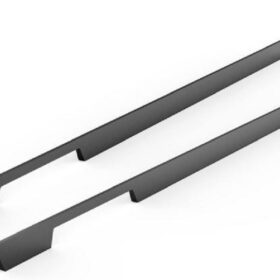Comparing Different Types of Kitchen Counter Handles
Kitchen counter handles, often overlooked, play a significant role in the functionality and aesthetics of any kitchen. Choosing the right handles can enhance the overall design while providing a comfortable and practical experience. This comprehensive guide will explore the various types of kitchen counter handles, their advantages, and considerations for choosing the perfect match for your kitchen.
Types of Kitchen Counter Handles
1. Cabinet Pulls
Cabinet pulls are the most common type of counter handle. They extend horizontally from the cabinet, providing a solid grip for opening and closing drawers and doors. Cabinet pulls come in various shapes, sizes, and finishes, making them suitable for both traditional and contemporary kitchens.
2. Knobs
Knobs are circular or square handles that protrude from the cabinet surface. They are generally smaller than cabinet pulls and offer a more discreet and elegant look. Knobs are best suited for smaller cabinets and drawers, as they can be more difficult to grip on larger surfaces.
3. Edge Pulls
Edge pulls are sleek and convenient handles that are mounted on the top or bottom edge of the cabinet door or drawer. They provide a seamless and ergonomic grip, eliminating the need for protruding handles that can obstruct countertop space.
4. Built-In Handles
Built-in handles are integrated into the cabinet design itself. They can be notches or grooves cut into the cabinet door or drawer, or they can be magnetic catches that are activated by a slight push. Built-in handles offer a minimalist and modern look, maximizing countertop space and creating a clean aesthetic.
Material Considerations
Counter handles come in a wide range of materials, including:
Metal: Durable, corrosion-resistant, and suitable for various kitchen styles.
Ceramic: Heat-resistant, scratch-proof, and adds a touch of elegance.
Stone: Luxurious, natural feeling, and suitable for traditional or modern kitchens.
Wood: Warm, organic, and complements wooden cabinets and countertops.
Acrylic: Lightweight, shatter-resistant, and comes in a variety of colors and shapes.
Factors to Consider
When choosing counter handles, consider the following factors:
Style: Match the handles to the overall kitchen design.
Size: Choose handles that are proportionate to the cabinet size and drawer width.
Finish: Select a finish that complements the cabinet color and countertop material.
Convenience: Opt for handles that provide a comfortable grip, especially for frequently used drawers and cabinets.
Installation: Ensure the handles can be easily installed without causing any damage to the cabinetry.
-
2024-11-29Top Trends in Modern Kitchen Cabinet Pulls for 2024
-
2024-11-28The Ultimate Guide to Modern Kitchen Cabinet Pulls- Materials, Styles, and Tips
-
2024-11-27Elevate Your Kitchen Design with These Must-Have Modern Cabinet Pulls
-
2024-11-26Sleek and Stylish- The Best Modern Kitchen Cabinet Pulls for a Contemporary Look










